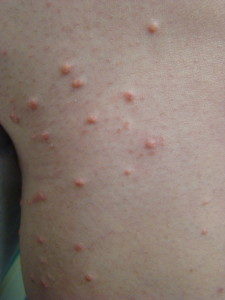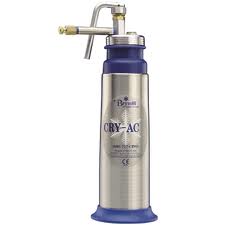Molluscum
What is Molluscum?
Molluscum usually appears as skin-colored or pink bumps 1-2mm in size. Their surface sometimes appears waxy or pearly, and they often have a dimple in the center. Sometimes, when the immune system fights the virus, the bumps become red or develop a surrounding rash. They can appear anywhere on the body, and the typical child has 10-20 spots at a time. The bumps usually appear 7 weeks after exposure to the virus but sometimes can take many months to appear. Molluscum is more common in the summer when the weather is warm and humid.
Molluscum is seen more frequently in children because their immature immune systems are less able to fight the virus. They are spread by skin to skin contact or by objects such as towels. Adults, however, can get molluscum as well. In adults, the spots often appear on the genitals, abdomen and inner thighs, and may be spread through sexual contact. If an adult gets numerous bumps or very large ones, particularly on the face, this may mean that the immune system is weakened.

How is Molluscum Diagnosed?
A dermatologist can often diagnose molluscum just by looking at the skin. Once the diagnosis is made, the question is whether or not to treat. The bumps frequently go away without treatment, so families of young children with molluscum may elect to the leave the bumps alone.

How is Molluscum Treated?
Treatment can be frustrating because there is no medication that directly kills the virus. In our office, we usually start with liquid nitrogen, which kills the infected skin cells at its temperature of minus 200 degrees Celsius. Since liquid nitrogen can be uncomfortable for young kids, we recommend a Cantharidin (“Blister Beetle Juice”), a topical medication derived from the blister beetle. This medication is painlessly applied to the skin but later causes blistering, hopefully killing the infected skin as it heals. Both liquid nitrogen and Cantharidins require multiple treatments, and it is common for new bumps to appear as others fade. Finally, we can treat resistant or widespread molluscum with an injection of Candida proteins. A series of 3 injections spaced about a month apart can stimulate an immune reaction that removes the molluscum. There are a number of prescription creams, such as imiquimod, which may also be helpful. They generally cause less discomfort than the in-office treatments, but they can take weeks to months to see improvement and may not work for everyone.
Here at Krauss Dermatology, we always work closely with our patients to determine which treatment or combination of treatments is most appropriate for them.


